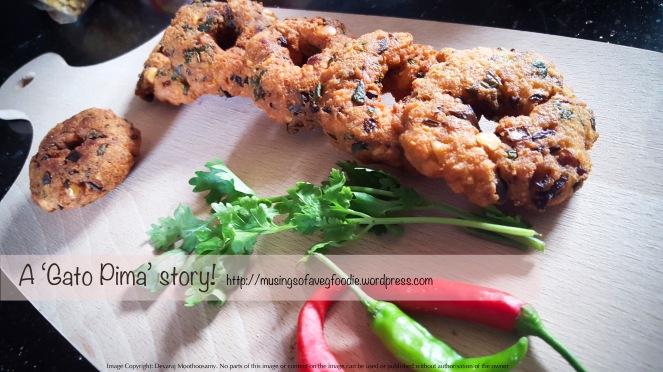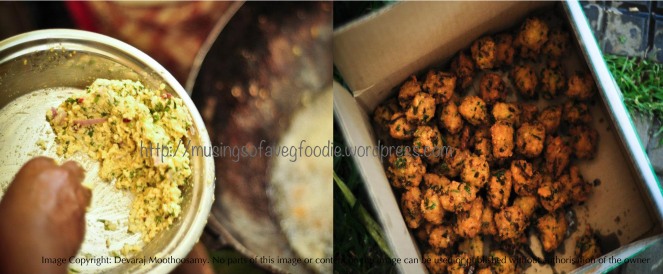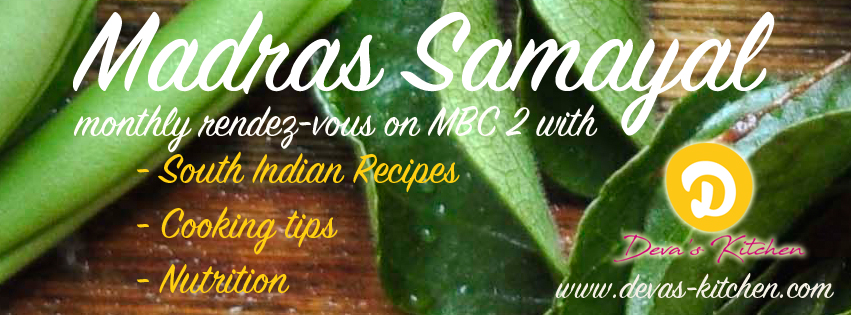A mere mention of the name and any Mauritian’s mouth would start watering. Crunchy on the outside and deeply soft on the inside, the spicy and distinctly flavourful ‘Gato Pima’ is by default the most famous and prized snack of Mauritius. There is rarely a family gathering, Sunday morning breakfast, late afternoon teatime, after school snack where the ‘Gato Pima’ does not make its way on the tables. It is something no one would ever refuse, at any time! 🙂

The term ‘Gato Pima’ literally translates to ‘Chilli Cakes’. Gato= cake (in the Mauritian context, Gato can mean any type of savoury and sweet snack) and Pima is the Creole term for Chilli. However, unbefitting to the name, Chilli is in fact just a taste enhancer in the Gato Pima. The main ingredient of the Gato Pima is the Split Pea (a.k.a Dal Tipois in Mauritius). The Split Pea is left to soak for some hours, then ground coarsely and mixed with herbs such as coriander, chopped onions, shallots, green or red chillis and several spices, before being shaped either into doughnut-like rings or small dumplings and deep fried. The name ‘Gato Pima’ might have been coined due to the extensive usage of Chilli in the preparation and thereby its hot flavour.

Generally, the doughnut shaped Gato Pima, as seen in the picture above, is found in homes and during more homely preparations while the dumpling type is mostly found at the counter of the famous ‘Marsan Gato Pima’. The ‘Marsan Gato Pima’, who is actually a street side cake seller, is an inseparable part of urban and rural Mauritian street scenes.

If we had to translate the term Gato Pima to cater to the understanding of a larger audience, I suppose the term might have been ‘Split Pea croquettes, enhanced with oriental herbs and spices’. 🙂
Now, from where comes the Gato Pima? Mauritius is a lovely melting pot of flavours. The social set up of the island has produced a profusion of intercultural exchanges while maintaining some distinct essence in each cultural component. Mauritian Food as such is verily, food from either India, China, Europe and Africa adapted to the local context. This adaptation has usually been based on the availability of ingredients and preparation time to suit demanding work schedules of a toiling immigrant population.
In this process a sort of ‘food genre’ has evolved with somewhat unique flavours but strongly inspired from the erstwhile homelands of the immigrants.
The Gato Pima is no exception. Back in South India, and several parts of North India there is a popular snack called the ‘Masala Vadai’ or ‘Dal Vada’. Popular in homes, on the streets and on most festive tables, the Masala Vadai is in fact extremely similar to the Gato Pima. Methods of preparation and spices are minutely different and ‘Kadalai Paruppu’ (Split Bengal Gram) is preferred over Split Peas. The texture of the Masala Vadai is more or less identical to the Gato Pima while the taste differs due to herbs used and spice mixes.

Another rather similar snack is the Middle Eastern ‘Felafel’ which is a deep fried patty made from ground Chickpeas. Though, there is more similarity between the Masala Vadai and the Gato Pima than with the ‘Felafel’.
Undoubtedly, the Gato Pima has forayed into Mauritian land from Indian kitchens where it is still found in traditional celebrations and religious ceremonies. For example, most Tamil families in Mauritius prepare the Gato Pima on early Deepavali mornings as sacred offering. During all rituals following the demise of a family member, the Gato Pima is always prepared. I am of the strong opinion that this emphasis on Gato Pima has been a constant link to India, to the Vadai. It has been the symbol of a traditional ‘Homeland’ preparation and thereby never missed on any special occasion. The Gato Pima also finds its way in a famous dish known as the ‘Mor Kolombu’ (from Tamil Mor Kuzhambhu).
Another very popular usage of Gato Pima is in the ‘Cari Bari’. The dish is a spicy curry in which fried Gato Pima is added and left to soak before serving. Famous among descendants of North Indian immigrants in Mauritius, the ‘Cari Bari’ is a wedding special.

Today, the Gato Pima goes beyond all ethnic and cultural differences, it is Mauritian by all means. A deep fried delicacy that binds the Mauritian palate to a singular unifying cultural expression.
Mauritian food is as such, each dish, each snack, each sweet, carries a story…a voyage through history. The nature of this multicultural island has been changing everyday for the last 200 years through subtle currents of socio-economic power, cultural observation, assimilation and sharing. Through the Gato Pima, we see the adaptation and anchoring of a foreign dish into a permanent component of Mauritian food..
With these few thoughts, I leave you to a great day. Part 2 coming soon..
Copyright: Devaraj Moothoosamy. No parts of this article (including pictures) can be copied and reproduced without prior authorisation from the author. Ethical and respectful sharing is allowed, from the original source.


Indeed an indelible component of the Mauritian street food and Deepavali! 🙂
I’ve also heard it being called ‘Gato Dal’ but to me, and I guess to many others as well, that just wouldn’t ever be evocative enough! :p
Brillant post!So many points duly addressed, wondering if Part 2 would actually be a recipe. 😉
Thank you for the time and effort you put in taking us on this beautiful food journey!
Your work somehow reminds me of Saransh Goila’s ‘India on my Platter’. 🙂
LikeLiked by 1 person
Well, Gato Dal would have been more appropriate though. But, we are so accustomed to ‘Gato Pima’. Part 2 might indeed be a recipe. 🙂
LikeLike